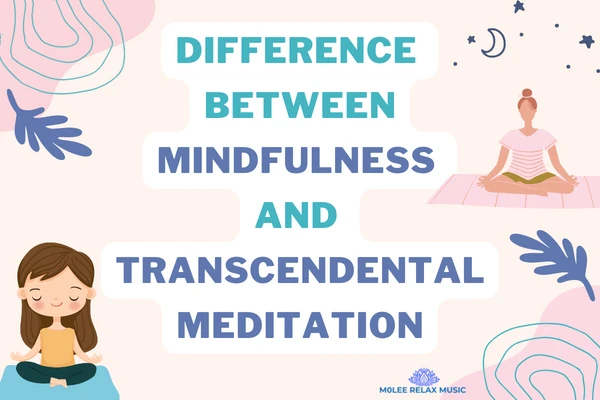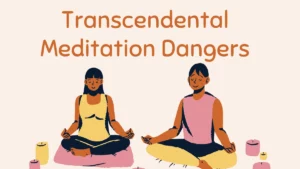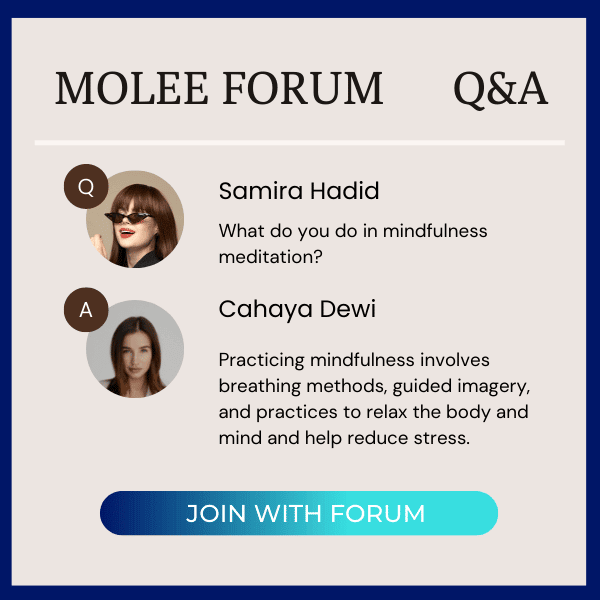Table of Contents
- What is mindfulness?
- Mindfulness Meditation
- What Exactly Is Transcendental Meditation?
- How To Do Transcendental Meditation?
- What Are TM Mantras?
- What Are The Unique Elements Of Transcendental Meditation?
- What Are The Benefits Of Transcendental Meditation?
- What Is Your Impression Of Transcendental Meditation?
- Why Do People Pay For Transcendental Meditation?
- What Is Transcendental Meditation like?
- How long does Transcendental Meditation Take To Work?
- Has Anyone Failed At TM Meditation?
- The significant differences in Mindfulness vs Transcendental Meditation
- 1. Mindfulness Is A Quality; Transcendental Meditation Is A Technique
- 2. Tools Used During Meditation
- 3. The Effort That The Practitioner Has To Put In
- 4. Origin of the meditation technique
- 5. The Organization Level
- 6. The Way Of Learning
- 7. The Tradition
- 8. Goal of the meditation
- 9. EEG Signals Of The Brain
- Final Thoughts
- FAQs on mindfulness and transcendental meditation
Mindfulness vs transcendental meditation is a tough call to make! But read this article for a hand in selecting between both.
Do you have your eyes on the most profitable spiritual practice that gives you serenity, equilibrium, balance, and calmness to benefit both psychological health and emotional well-being? Well, you are at the right place as we are going to talk about mindfulness vs transcendental meditation. We will be discussing the in-depth detail and comparison of these concepts and how they can benefit you.
Moreover, we will also be discussing the types in detail and will be answering some of the most asked questions related to transcendental meditation and mindfulness. Both mindfulness and transcendental meditation involve focus, concentration, attention, deep breathing, and deep awareness.
Although the aim of both of these practices is similar, that is to give peace, stability, and calmness to your brain they are somehow different from each other. Both of these meditation approaches belong to different traditions and are learned differently. Similarly, they are practiced differently and provide different effects on the brain. The following details and pieces of writing tell you everything about these concepts, their similarities, and their differences.
Read our detailed article on TM vs Mantra Meditation to know how these are differ from each other.
What is mindfulness?
The moment-to-moment engagement of the understanding of one’s self without judgments is called mindfulness. Mindfulness is a self-regulated practice that targets training the awareness, attention, and focused span of one’s brain to stay conscious and attentive, but without judgments. In simple words, we can say the training of staying aware and staying attentive is called mindfulness.
Activities like Tai-chi and yoga are also similar to meditation but are less popular. In addition to providing you with overall enhancement in general mental well-being, the development of clarity, focus, concentration, and serenity is also achieved with adequate mindfulness practice. Right meditation not only gives you cognition, awareness, satisfaction, and calmness but also helps in reducing stress, pressure, and ruminations so that you can keep your focus on the positive rather than the negative in your surroundings.
3 Pillars Of Mindfulness
The studies on mindfulness have classified mindfulness into three types, based on their procedures that affect the chemistry of the brain, providing you with different outcomes. These are:
Focused Attention
Focused attention is the first pillar that refers to the ability to maintain focus and concentration to minimize distraction simply by ignoring interruptions. This also includes the repeated processes of focusing and refocusing attention on the object you want to concentrate on.
Open Awareness
The second pillar of mindfulness is open awareness. It refers to staying receptive to objects you are focusing on while staying fully aware, focused, and concentrated without directly attaching to those objects or getting lost in them. It means that you are totally focused on the object but still aware of the surroundings and not lost in them.
Kind Intention
Kind intention is that state of mind that keeps you positive, loving, and compassionate towards all living beings. It is said to be the base of most meditative practices. The kind intention keeps you positive both internally and externally by shifting your thought structure from negative to positive.
Benefits Of Mindfulness

Most of the researchers on mindfulness have obtained the following 4 benefits.
Reduced Rumination
Noticeable reduction in rumination is one of the most achieved advantages of mindfulness. Research has shown that meditators have improved working memory and cognitive flexibility. They were able to balance the attention so that you don’t overthink or deeply consider anything.
Stress Reduction
Mindfulness is also helpful in minimizing stress by shifting different cognitive procedures with each other to deal with the underlying issues that otherwise can develop into disorders. Moreover, the research on mindfulness has also concluded that it maximizes positivity and minimizes the negativity and anxiety around the meditator. This ultimately results in minimizing stress.
Enhanced Focus
There was research that was done on the examination of focus and mindfulness with each other. It concluded that the control group that had no mindfulness experience was lacking in performance that involved focus and concentration, compared to the group that has experienced mindfulness meditators. This showed that meditation also helps in increasing focus and maximizing the attention span.
Increasing Cognitive Flexibility
Mindfulness helps reduce stress and rumination and also increases cognitive flexibility. Since it assists people in becoming less reactive to extreme situations, it also helps them increase their cognitive flexibility. Those people who practice mindfulness and meditation daily develop self-observation that ultimately disengages them from negative surroundings and helps in making their vision broad and flexible.
Mindfulness Meditation
As we have now talked about meditation, its history, pillars, and major benefits we will now focus on what mindfulness meditation is, how to perform it and what are its basic types.

What Is Mindfulness Meditation?
When you have a rush in your mind and racing thoughts in your brain, you often go with practicing mindfulness. It is a training process that involves the training of the mind to help you slow down the rushing thoughts, minimize the negativity and give peace to both your body and mind. The combination of meditation and mindfulness results in staying fully focused and concentrated on the present so that you can mainly focus on feelings, sensations, and thoughts of the present without judgment.
How To Do Mindfulness Meditation
Learning mindfulness meditation is easy and not tough but demands practice and continuous effort. You can take help from an online program or can hire a teacher to help you with your meditation practices. Moreover, keep in mind if you are practicing mindfulness meditation to sort out some of the specific health concerns then you should go with a doctor or some professional meditator to guide you in the best way.
The following five steps are taken to successfully practice mindfulness meditation. Read the details twice so that you can know what you have to do if you want to practice highly beneficial and productive mindfulness meditation.
1. Getting Comfortable
Look for a comfortable, quiet, and peaceful place to sit on a chair or a floor while staying straight. Make sure you are sitting in the right posture with your neck, head, and back in a straight position. Keep in mind that your neck, head, and shoulder are not stiff. Moreover, make yourself as comfortable as you can and for that, you can also go wearing loose clothes.
2. Select Time And Consider A Timer
Although it’s not necessary, it is helpful to keep you aware of how much time it has been while you are meditating. Go with smaller sessions of meditation at the start which is from 5 minutes to 7 minutes and then increase the session up to 30 minutes over time. Timer helps you focus more on meditation by eliminating the fact that it’s time to do something else. It will keep you aware and will help you in maintaining your attention so that you can focus mainly on your practice.
3. Breathing
Divert your attention towards breathing. Make sure you are fully focused on your breath and that you are aware of the surroundings. Feel the sensation of air moving inside and outside of your body. You can do this by focusing on your belly as it rises and falls with the entrance and leaving of the air from your nostrils. Make sure to take deep breaths. And you can do this by inhaling from the nose and exhaling from your mouth. You can also pay attention to the change in the temperature of the air that is inhaled with the air that is exhaled.
4. Focus On Your Thoughts
The goal of meditation is not to block your thoughts, instead, it is to get comfortable and easy with them. You should not suppress or ignore the thoughts instead should stay calm and focus on them as they are passing by. Notice their shift and change and feel like the thoughts are similar to the clouds passing by quietly, quickly, and without affecting you.
5. Stop
Stop as quickly as you notice that your thoughts are carrying you away and distracting you. While stopping and giving yourself a break, make sure to observe where your mind exactly was, whether it was a fear, worry, or hope. Make sure to observe without making judgments and keep on breathing.
One of the more important things in the meditation process is to stay soft with yourself and never be harsh, regardless of what happened. Keep in mind successful mindfulness meditation is the practice of focusing and refocusing on the present while staying calm and easy even after you have been distracted by your thoughts.
Types Of Mindfulness Meditation
Two basic types of mindfulness meditations are breathing meditation and body scan. We will look into the details of both of these and will also look at what exactly Buddhist meditation is.
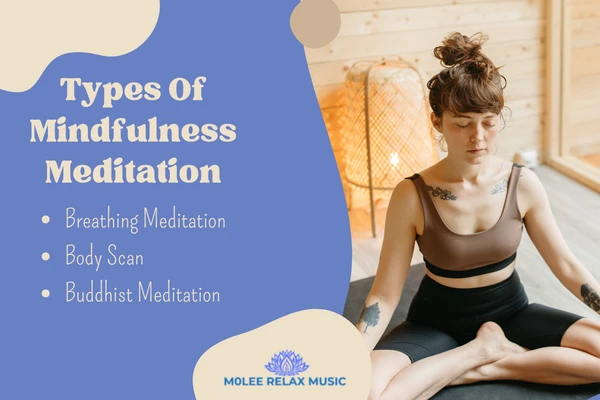
Breathing Meditation
Breathing meditation involves deep breathing which is beneficial for the achievement of the goals of meditation. This not only gives you a peaceful feeling but also maximizes focus, concentration, and attention span. What you have to do is to take breaths by focusing mainly on the breathing itself and counting them silently.
You have to count each inhale and each exhale. This ultimately shifts your thought towards counting the breaths and will divert your attention from intrusive thoughts that otherwise can cause destruction. I will recommend you go with breathing meditation at the same time each day so that you can get the most benefits out of it.
Body Scan
The body scan is the second type of mindfulness meditation that involves the practicing of meditation to scan and check for your body tension, stress, pain, or anything that is not common. It is used in the medical field to solve most health problems via simple meditation.
The body scan mindfulness meditation practice connects you deeply with your emotional and physical self. It involves tuning yourself to your body to notice sensations and uncommon feelings without making judgments. This is not only relaxing but also very calming and soothing to the pains, pressures, and not-so-common stress complaints of the body.
Buddhist Meditation
Buddhist meditation is the meditation practice in Buddhism. It involves training and transforming the mind towards the development of positivity, clarity, encouragement, and concentration. Learning different habits and patterns of the mind and developing new positive thoughts is what Buddhist meditation teaches. It is extremely helpful in transforming your thoughts and giving you a new rise and new lead to a different and more positive understanding of life.
What Exactly Is Transcendental Meditation?
After focusing on meditation, mindfulness meditation, and their types and benefits, we are now going to look for what exactly is transcendental meditation. Transcendental meditation is one of the special techniques of meditation that is getting popular and famous from the latest decades in the western areas.
The popularity of transcendental meditation arises due to its associations with celebrities and their endorsements towards it. Celebrities right like Hugh Jackman, Oprah Winfrey, and Jerry Seinfeld use it. This involves the repetition of specific phrases repeatedly to induce relaxation and tranquility in the meditator. It helps in the reduction of blood pressure, anxiety, and stress by improving overall mental and physical health. Let us now look at how to perform transcendental meditation.
How To Do Transcendental Meditation?
Transcendental meditation is practiced two times a day that involves sitting on the floor comfortably and repeating a word or phrase to make it the spot of your attention. It is very simple and very effortless to do. You have to sit on the floor while staying comfortable. Wearing a loose dress and sitting in an ergonomic posture can help you increase comfort.
Close your eyes and repeat a phrase or a word that is called a mantra to shift your consciousness from other surrounding distractions towards it. These mantras are not words or feelings or objects, instead, they are sounds that assist the meditator to divert the attention and active thinking toward the in-depth focus and concentration towards one’s self.
Read our article on how to do transcendental meditation step-by-step guide.
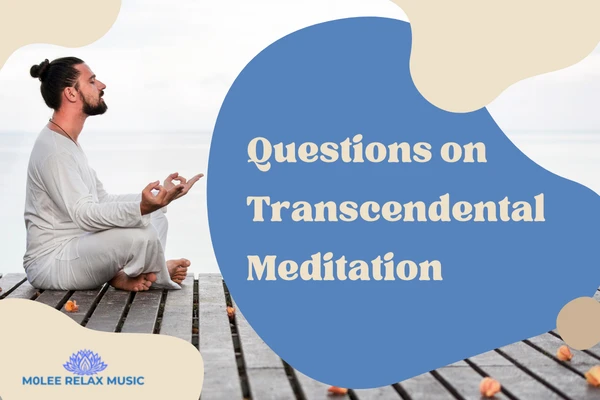
What Are TM Mantras?
TM mantras are not words or phrases or sentences to represent feelings, objects, or experiences, instead are sounds that you use in transcendental meditation work. These mantras are extremely helpful in directing your attention toward yourself. Moreover, these mantras also divert your focus from active thinking to the present, and towards the deeper level of yourself and self-awareness.
Explore the comprehensive list of mantras for transcendental meditation.
What Are The Unique Elements Of Transcendental Meditation?
Transcendental meditation is termed a unique way of meditating because it involves unique elements that are not used in other types of meditation procedures. It involves no contemplation, no concentration, no focus, and no control of the mind. TM is comparatively easy, enjoyable, and effortless to do.
You can perform it by simply sitting on a chair or a floor and making sure that you are sitting in a highly comfortable zone. You have to repeat the mantra to divert your focus from the surroundings towards that one spot. This also helps you in diverting your attention from the distracted surroundings towards the deeper level of yourself, unlike other meditation practices.
What Are The Benefits Of Transcendental Meditation?
Transcendental meditation is one of the most performed techniques of meditation that gives out physical, mental, emotional, and cognitive benefits. We will look at some of the key benefits that you can take from transcendental meditation. Transcendental meditation helps in lowering blood pressure. It improves sleep. It can manage the pain and stress in your body by simply distracting you from the pain. Moreover, a noticeable reduction in anxiety, depression, and stress can also be achieved by transcendental meditation.
It is one of the management techniques used for PTSD, and post-traumatic stress disorder. It also helps in the improvement of self-esteem and can help you develop problem-solving and cognitive skills. TM improves creativity and intelligence. Moreover, the noticeable enhancement in focus, memory, and energy is also observed as a result of transcendental meditation. Transcendental meditation also helps in clearing feelings and thoughts and increasing gratitude and inner peace.
What Is Your Impression Of Transcendental Meditation?
I prefer doing transcendental meditation when I want to get relaxed and calm. It is a very good and productive way for those who want to de-stress themselves positively by minimizing the surrounding distractions and maximizing the focus on oneself.
Read our life-changing article on transcendental meditation.
Why Do People Pay For Transcendental Meditation?
People pay for transcendental meditation to get the best outcome for the investment of time that they are investing and spending on meditation. Those who are paying for learning transcendental meditation learn to practice the TM easily and effortlessly to get the maximum benefits of it. They pay to get the benefit of the TM in every possible way. Moreover, learning transcendental meditation techniques costs around $550 to $990.
What Is Transcendental Meditation like?
Transcendental meditation is like simple meditation that is somewhat different but gives you the same benefits that you can obtain from mindfulness or mindfulness meditation. It is different in its procedure but is the same in its effects. It involves the repetition of a mantra to divert your attention towards the mantra, ultimately leading you to put your focus on yourself to increase peace, calmness, and focus.
The transcendental meditation books provide a better understanding of the TM technique and explain it simply up to depth.
How long does Transcendental Meditation Take To Work?
Transcendental meditation takes around 8 to 10 weeks to restructure the neurology of the brain. But you have to make sure that you are practicing daily as the daily practice of transcendental meditation can enhance the volume of the gray matter, in some specific areas of the brain, to help you get the most out of the meditation process.
Has Anyone Failed At TM Meditation?
No, no one has ever failed at transcendental meditation after practicing the instructions and steps properly. Those who have failed have performed the meditation against the instructions. This has been told after they were asked what was their procedure for doing the transcendental meditation.
The significant differences in Mindfulness vs Transcendental Meditation
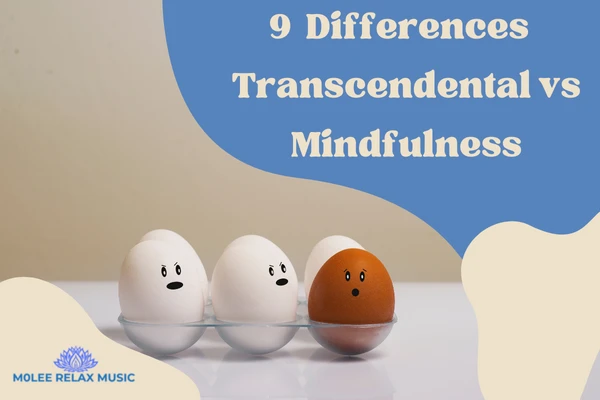
Until now we have learned about mindfulness, mindfulness meditation, and transcendental meditation and the details of each. Now we are going to talk about the key differences between both of these meditative modes to help you guys select the most effective procedure according to your choice.
1. Mindfulness Is A Quality; Transcendental Meditation Is A Technique
Mindfulness is the quality of the brain to stay aware that is learned via paying concentration, focus, and attention towards the purpose goal mainly in the present time. But make sure that the awareness you are creating in the present time is non-judgemental. Moreover, mindfulness is said to be a positive way of living.
On the other hand, meditation is a practical technique that involves the practice of an individual focusing his mind on a specific thought, specific object, or specific activity. It gives you clarity of mind, thoughts, and emotions to give you a stable state by simply training the awareness and attention of your brain.
2. Tools Used During Meditation
Meditation revolves around a mantra that is different from the tool used for mindfulness. Mantra is a unique sound that is given to each individual in transcendental meditation and he has to repeat it continuously during his sessions of meditation. This is important to distract the practitioner’s distracted thoughts to make him more peaceful, more comfortable, and calmer. Transcendental mantras are short, they are memorable and they are extremely helpful in shifting your attention from negative to positive.
Whereas mindfulness is the focus on breathing and diverting the attention towards the focal point which is the anchor. An anchor is a tool used in mindfulness that is different from a mantra used in meditation. There are different types of anchors, the focus points such as physical sensations, feelings, some objects, or most of the time they are the parts of the body.
3. The Effort That The Practitioner Has To Put In
Meditation is an effortless approach that is widely different from mindfulness. It does not involve that training of the brain nor does it involve that training of the attention. It is completely effortless and is very easy to perform. Meditation involves enabling the body and mind to reach a state of rest and calmness.
On the other hand, mindfulness demands effort to train the concentration and attention of the brain for your awareness and focus, so that you can focus more on the positive than the negative and can ignore the distractions from the surroundings, and can achieve a state of convenience and relaxation.
4. Origin of the meditation technique
Mindfulness has been in practice for thousands of years and is set back to Christianity, Judaism, and Islam. It was first introduced by Lord Budha, one of the biggest influencers of traditional concepts. On the other hand, meditation came into practice after Maharishi Mahesh Yogi. And was taught by Swami Brahmananda Saraswati who was the Hindu Monk. Since the 1950s till now, meditation is one of the most practiced ways of meditating to get a high level of peace, relaxation, and calmness.
5. The Organization Level
This is one of the biggest differences between transcendental meditation and mindfulness. The TM is trained by professionals and is often trademarked by an official organization. This demands payment and you must have to pay for the course to learn. The course is taught by a professional meditator and a registered teacher.
It cost around dollar 900 to $1,000. On the other hand, mindfulness has no official organization; it does not belong to any organization. It is said to be an old practice belonging to Buddhism. You can learn mindfulness for free by simply looking at online videos, blogs, books, and different apps.
6. The Way Of Learning
This is another difference between meditation and mindfulness. You can learn meditation from a professional teacher or someone who is officially teaching you meditation. You have to pay for it and have to look for a professional meditator to make you learn meditation in the best possible way.
On the other hand, mindfulness is self-learned and you don’t have to depend on others to learn the technique. What you have to do is practice mindfulness regularly to get the most benefits out of it. Moreover, mindfulness can also be practiced with your mates, and in groups and is also comparatively easy to learn on your own.
7. The Tradition
Mindfulness belongs to the Vedic tradition which is also known as ancient Hinduism or Vedic. The origin of mindfulness belongs to Brahmanism and is often referred to as the experience and teachings that were in practice among the peoples of the Indian subcontinent in the old times.
Since there was no absolute religion in the Vedic era, there was no guidance nor any control over the belief and practices of that system. On the other hand, meditation belongs to Buddhism and is followed because it is one of the most practiced acts of Lord Buddha.
8. Goal of the meditation
The goal of mindfulness is to improve focus and achieve relaxation by focusing and paying attention to feelings and thoughts without making any judgments. Mindfulness also involves practices to relax the mind and body so that you can reduce stress and pressure on your brain.
On the other hand, meditation is responsible for providing you with peace, balance, and calmness to provide benefits to your mental health, physical health, and emotional health. Moreover, it is also helpful in coping with stress by practicing focusing and refocusing your attention toward something relaxing and calming.
9. EEG Signals Of The Brain
When it comes to mindfulness the prefrontal cortex area of the brain is responsible for giving you a sense of control, focus, and peace. This is because this region of the part is responsible for problem-solving and emotion control. As you practice mindfulness the gray matter increases in volume and ultimately results in increasing the activity of the prefrontal cortex.
This gives you a comparatively more controlled, easy, calm, and relaxing feeling. And when it comes to meditation the alpha waves and relaxed state theta waves are normally detected during the procedure of meditation. According to Dr. James Hardt’s book “the art of smart thinking“, these waves are responsible for maximizing problem-solving abilities. Meditation in this regard is a tool that gives you lifelong advantages in brain health, as soon as you perform it daily.
Final Thoughts
Despite lots of differences between mindfulness and transcendental meditation, some of the concepts are overlapping in this above-mentioned piece of writing. Your selection to the practice depends upon your choice and your personal preference. Everything related to mindfulness meditation and transcendental meditation is mentioned above. Whatever practice you select and follow you have to keep in mind that you are following it consistently if you want to get the best possible results.
FAQs on mindfulness and transcendental meditation
What is the difference between Zen meditation and transcendental meditation?
Zen meditation involves the focus on breathing and is a combination of Vipashyana and Samatha. It is practiced to see through reality, with the help of prodding and koan. Whereas transcendental meditation involves no control, no training, and no concentration from any aspect, instead it forces you to repeat the mantra that diverts your attention from the negative to the positive.
Can I learn TM meditation online?
Until now it is said that you cannot learn transcendental meditation without a professional meditator or on your own from an online course. It is taught by certified meditators to help you develop excellent skills and regular practice of meditation to get the best out of it.
Can I learn Transcendental meditation on my own?
No transcendental meditation cannot be learned on your own because it demands a certified practitioner and help from a professional meditator. Since it is a technique that is learned, you cannot do it on your own. Transcendental meditation aims to provide you with thoughts, clarity of mind, and balanced emotions so that you can have a stable and relaxed mental state.
Do TM meditators believe they can fly?
No, they do not believe that they can fly but because of the Yogik flying practice, it is being wrongly conceptualized. The flying here is not floating in the room or somewhere else but is the physical changes in the neurons of the brain, to give you maximum stability and strength of thoughts, making you feel like you are doing whatever you are thinking.
How are the Vedas and transcendental meditation related?
Transcendental meditation is said to be the absolute and branded form of the Vedas meditation technique. It came into being by Maharishi Mahesh Yogi in the decades of 1960s and 1970s. At the very start of it, it was known as deep meditation, then it was called deep transcendental meditation, and now its name changed to transcendental meditation.


